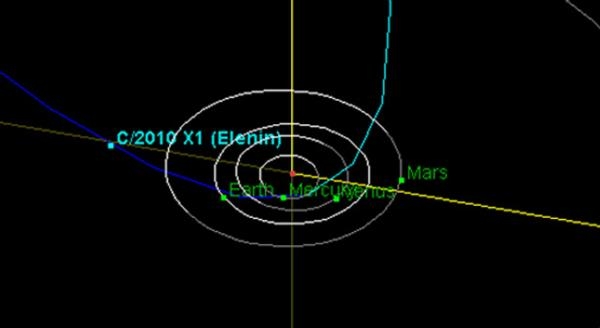Sat, Aug 20, 2011
NASA Says It May Not Even Be Visible To The Naked Eye
Often, comets are portrayed as harbingers of gloom and doom in
movies and on television, but most pose no threat to Earth. Comet
Elenin, the latest comet to visit our inner solar system, is no
exception. Elenin will pass about 22 million miles (35 million
kilometers) from Earth during its closest approach on Oct. 16,
2011.
NASA Graphic

Also known by its astronomical name
C/2010 X1, the comet was first detected on Dec. 10, 2010 by Leonid
Elenin, an observer in Lyubertsy, Russia, who made the discovery
"remotely" using an observatory in New Mexico. At that time, Elenin
was about 401 million miles (647 million kilometers) from Earth.
Since its discovery, Comet Elenin has – as all comets do
– closed the distance to Earth's vicinity as it makes its way
closer to perihelion, its closest point to the sun.
NASA says there have been incorrect speculations on the Internet
that alignments of comet Elenin with other celestial bodies could
cause consequences for Earth and external forces could cause comet
Elenin to come closer. "Any approximate alignments of comet Elenin
with other celestial bodies are meaningless, and the comet will not
encounter any dark bodies that could perturb its orbit, nor will it
influence us in any way here on Earth," said Don Yeomans, a
scientist at NASA JPL.
"Comet Elenin will not only be far away, it is also on the small
side for comets," said Yeomans. "And comets are not the most
densely-packed objects out there. They usually have the density of
something akin to loosely packed icy dirt. "So you've got a
modest-sized icy dirtball that is getting no closer than 35 million
kilometers [about 22 million miles)," said Yeomans. "It will have
an immeasurably miniscule influence on our planet. By comparison,
my subcompact automobile exerts a greater influence on the ocean's
tides than comet Elenin ever will."
Astrobiologist David Morrison says NASA doesn't yet know if
Comet Elenin will be visible to the naked eye. "At the rate it is
going, seeing the comet at its best in early October will require
binoculars and a very dark sky. Unfortunately, Elenin is no
substitute for seeing comet Hale-Bopp, which was the brightest
comet of the past several decades," he said. "This comet may not
put on a great show. Just as certainly, it will not cause any
disruptions here on Earth. But, there is a cause to marvel," said
Yeomans. "This intrepid little traveler will offer astronomers a
chance to study a relatively young comet that came here from well
beyond our solar system's planetary region. After a short while, it
will be headed back out again, and we will not see or hear from
Elenin for thousands of years. That's pretty cool."
More News
Its Offerings Are Lighter, Cleaner, and Now Pushing Past 1,000nm on SAF Jet Fuel DeltaHawk’s diesel-powered aircraft lineup has seen incredible upgrades over the last few yea>[...]
The Airplane Experienced A Total Loss Of Engine Power On December 3, 2025, about 1600 central standard time, a Mooney Aircraft Corp. M20K, N57229, was substantially damaged when it>[...]
Make Sure You NEVER Miss A New Story From Aero-News Network Do you ever feel like you never see posts from a certain person or page on Facebook or Instagram? Here’s how you c>[...]
Aero Linx: European Society of Aerospace Medicine (ESAM) As a pan-European, independent forum, it works to promote the safety and health of all persons involved in aviation and spa>[...]
“We are excited to see Wisk achieve this milestone, and I’m so proud of the team that made it possible. The team at Wisk has built advanced technologies across flight c>[...]
 Aero-TV: DeltaHawks Diesel Power Steps Into the Spotlight
Aero-TV: DeltaHawks Diesel Power Steps Into the Spotlight NTSB Prelim: Mooney Aircraft Corp. M20K
NTSB Prelim: Mooney Aircraft Corp. M20K ANN FAQ: Turn On Post Notifications
ANN FAQ: Turn On Post Notifications ANN's Daily Aero-Linx (12.20.25)
ANN's Daily Aero-Linx (12.20.25) Aero-News: Quote of the Day (12.20.25)
Aero-News: Quote of the Day (12.20.25)



